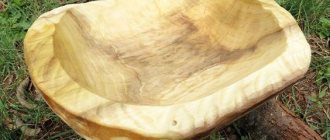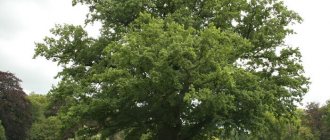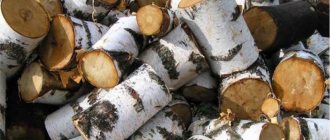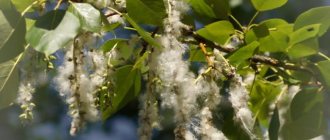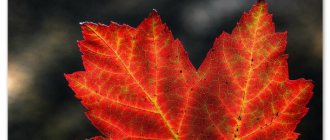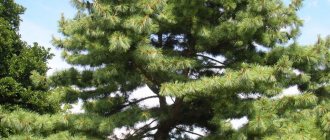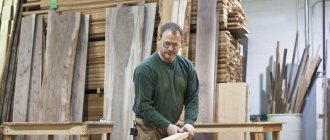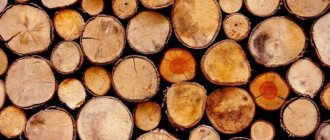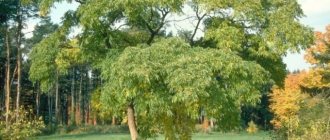The role of trees in human life cannot be overestimated. Oaks and aspens, birches and chestnuts, poplars and fir trees not only delight the eyes of those around them with beautiful bright outfits from spring to autumn, but also day after day they carry out tremendous work, which consists of saturating the air with oxygen, protecting the human body from tons of dust and other harmful substances , absorbing almost a quarter of street noise. In addition, green spaces can provide many useful fruits, and in the hot season they can save you from the sun. Landscaping streets, parks, squares and garden plots has become so popular in America and Europe that they even celebrate Arbor Day. So why don’t we adopt this wonderful tradition and plant, for example, the Yavor maple variety near our houses.
Why is the false sycamore maple called sycamore?
According to the legends of the ancient Slavs, a person was turned or “sworn” into this tree. Therefore, maple is never used to heat a stove, nor is it used to make coffins, considering it a great sin to place living people in the ground.
A man turned into a sycamore because of a mother’s curse on her disobedient children. When the musicians pass by a maple tree, they cut it down and make a violin. Its sounds, in the voices of children, tell how their mother committed a crime in front of them.
The Serbs have a different belief. A dry maple tree will turn green if it is hugged by a person who has been wronged unfairly. And, conversely, a green maple will dry out if a deeply unhappy or offended person touches it.
White maple, or sycamore
This tree from the maple genus is common in Europe - the central part, in Asia - in the southwest. The growing area covers France, Ukraine, northern Spain, Turkey, and the Caucasus.
False sycamore maple (sycamore) is a deciduous tree. Its height reaches twenty to thirty-five meters. The wide crown has a dome shape. The trunk bark of trees in the first years of life is smooth, with a gray tint. In mature trees it is rough, its scales flake off. The layers of bark with a different color are clearly visible: pale brown and pinkish.
The leaves are large, identical in size, both in length and in width - from ten to twenty-five centimeters. They consist of five blades. Their edges are jagged. The color is dark green, purple, crimson, yellowish, depending on the season. The yellow-green flowers are collected in hanging racemes up to twenty centimeters long. There are many flowers in the inflorescence, from twenty to fifty pieces.
The seeds, arranged in pairs, have a spherical shape, in the form of a lionfish. Each seed is endowed with small wings, thanks to which it flies when it falls. The wind carries the seeds over long distances.
The false sycamore maple, the photo of which you see in the article, is a strong tree. But it is also susceptible to the appearance of spots of different colors on the leaves: black, gray, brown. These are pathogenic fungi. Maple leaves are a breeding ground for lepidopteran insects.
Recipes
There are several options for using the leaves and bark of the sycamore tree. Here are some of them:
- The infusion is prepared as follows. A teaspoon of crushed sycamore tree seeds, as well as 2 teaspoons of crushed leaves, 1 tablespoon of crushed bark are mixed and poured with a glass of boiling water. Cook in a water bath for about 20 minutes. Remove from heat and dilute with a glass of boiling water. Strain and squeeze. Use 3-4 times a day, 50 ml. The infusion helps with diseases of the kidneys, bladder, bronchitis, colds, and inflammation of the respiratory tract. The same infusion can be used to wash purulent wounds and cuts.
- The bark of the sycamore tree in the amount of 12 grams is finely crushed and poured with a glass of boiling water. Cook in a water bath for 5 minutes. Remove from heat and leave for an hour. Express. Take 3 times a day, 50 ml. The decoction is recommended for intestinal disorders and diarrhea.
- Mix crushed seeds and leaves in equal proportions. Pour 1 tablespoon of the resulting mixture into a glass of boiling water and cook in an enamel bowl for 45 minutes. During cooking, the container must be covered with a lid. Remove from heat and drain. Take 20 minutes before meals, 3-5 times a day, 2 tablespoons. A decoction is prescribed for kidney diseases, inflammation of the upper respiratory tract, respiratory diseases, herpes, and inflammation of the gums.
- Leaves of the sycamore tree in the amount of 1 tablespoon are poured with a glass of boiling water. Cook in a steam bath for 30 minutes. Strain, cool to room temperature. Take half a glass several times a day. This recipe is used to relieve the symptoms of jaundice, scurvy, and kidney stones. Ideal as a tonic, antiemetic and diuretic.
- For prostatitis and impotence, the following remedy is recommended. Fresh green leaves of the sycamore tree are passed through a meat grinder. Squeezed, resulting in juice. For this recipe you will need 70 ml of juice, to which 30 ml of ethyl alcohol (96%) is added and left to infuse for several hours. Take before meals, 5-8 drops. The course of treatment can last up to 4 weeks, after which a month's break should be taken. There is another recipe for the treatment of prostatitis: in a thermos, pour 4 tablespoons of a mixture of motherwort, St. John's wort and bearberry (ingredients in equal proportions) with a liter of boiling water. Leave for an hour and filter. Take 3 times a day, 20 minutes before meals, with a teaspoon of maple syrup.
- To treat liver cirrhosis, hepatitis and cholecystitis, an infusion is prepared according to the following recipe: 4 lemons (2 with peel) are passed through a meat grinder. Add a glass of olive oil and a kilogram of maple syrup. The mass is mixed and poured into a glass jar. Take 30 minutes before meals, one tablespoon at a time. The course of treatment is 1 month. Up to four courses of treatment can be carried out per year. The resulting mixture must be stored in the refrigerator.
What is it grown for and where is it used?
False sycamore maple is valued for its wood. The description of the sycamore variety is given according to the characteristics of the wood. It is white, silky, shiny, and highly wear-resistant. White maple wood is used to produce furniture, fittings, musical instruments, flooring, and parquet. Sometimes the wood has a fibrous texture, which greatly increases its value. It is used for facing work.
White maple is a good honey plant. Its flowers produce nectar and pollen in abundance - raw materials for processing by bees, resulting in aromatic honey.
Secrets of planting and care
Regardless of the variety, the Pseudoplatan maple prefers open, sunny places and does not develop well in the shade. When planting white maple or sycamore, choose fertile soils that are well moistened and drained. The tree is planted away from buildings.
When planting in a row, maintain at least 2-3 m between the trees. The hole for planting is prepared in advance, 2-3 weeks in advance, so that the ground settles. After planting, a couple of days later, the tree trunk circle is sprinkled with an additional layer of earth.
Caring for false sycamore maple is not difficult. Young plantings are watered regularly, the tree is moisture-loving. After watering, the tree trunk circle is loosened and weeded.
New plantings are protected from frost (from minus 15-20C) with spruce branches and agro-fabric; an adult tree does not need such protection.
Sycamore is pruned annually, removing old, dry, broken branches. In spring, adjust the shape of the crown as desired. The tree trunks are regularly mowed down.
White maple in landscape design
This tree is resistant to strong gusts of wind, air pollution and salt. Therefore, it is popular for landscaping urban areas, roadsides, and sea coasts. Currently, maple is distributed north of its habitat in Scandinavia and the British Isles.
Throughout North America, wild white maples can be found in New York, New England and along the western Pacific coast. Trees are grown as a crop in many regions characterized by a temperate climate: for example, New Zealand, the Falkland Islands.
Meaning and Application
Maple wood
White maple is grown for its wood, white, with a silky shine, wear-resistant, used for the manufacture of musical instruments, furniture and fittings, flooring, including parquet.
Sometimes found wood with a wavy texture increases its value for decorative cladding (veneer).
Honey plant
The flowers produce pollen and nectar in abundance, producing aromatic, mild-tasting, pale-colored honey. Nectar production is less abundant than from Norway maple.
White maple in garden and park culture
White maple is remarkable for its resistance to wind, urban pollution and salt, making it popular for growing in cities, along roads salted in winter, and on the sea coast.
It is introduced and widely distributed in cultivation north of its native range in northern Europe, especially the British Isles and Scandinavia, as far north as Tromsø in Norway (seeds may ripen as far north as Vesterålen), Reykjavik (Iceland) and Tórshavn in the Faroe Islands .
Typical tree
In North America, wild (originating from cultivated plantings) white maples are common in New England, New York, and the Pacific Northwest.
Grown in many temperate parts of the Southern Hemisphere, very common in New Zealand and the Falkland Islands. It is considered an unwanted invasive weed in some parts of Australia (Yarra Ranges, Victoria).
The popular cultivar Acer pseudoplatanus 'Brilliantissimum' is remarkable for its vibrant orange-pink young foliage.
Russian sycamore
In the old days, the body of the gusli was built from sycamore wood, which is why they were called “yavorchatye” or more often “yarovchatye”.
In Russian, the word “sycamore” probably serves as a popular name for some other types of maple or maple in general.
In Russian poetry and epics, sycamore is mentioned both in connection with the gusli, and, apparently, as an element of archaic vocabulary of high style. For example, from Pushkin:
Sycamore Darnley
It is said that Mary I, Queen of Scots, saved her ailing husband, Henry Stewart, Lord Darnley, by restoring him to health under this magnificent “sycamore tree” (as the White Maple is called in Scotland) at Darnley in Glasgow.
Valuable wood
Wood obtained from trees of the Maple genus is considered very valuable and is in great demand.
Sycamore (norle-leaved maple) wood has a very attractive appearance, so its main use is in the production of furniture.
Heartwood and sapwood practically do not differ in structure and water content, therefore they are poorly distinguishable visually.
The wood of sycamore or white maple is light, almost white, with a slight yellowness and very beautiful.
Musical instruments
Maple has been used in the manufacture of musical instruments since ancient times. For example, back in the 9th century, the Slavs surprised the kings of Byzantium by playing the harp, which in those distant times was made from a hollowed-out dry plank of spruce or maple.
Sycamore maple was especially loved by music masters. In the Middle Ages, it became widely used in the manufacture of strings, bows and other musical instruments.
And from that time on, a tradition began to select the most curly material.
Curlyness
This is a wavy arrangement of fibers, especially in the root part of the tree. The “bird's eye” pattern, which is formed due to unopened buds, is also highly valued. In processing, maple pleases craftsmen. It is perfectly planed, bendable and retains its shape.
Copyright
The article was prepared based on materials: Wikipedia, CC BY-SA 3.0; photo credit: 1 - Franz Xaver, GNU 1.2; 2 - Radio Tonreg, CC BY 2.0; 3, 4, 6 - Rosser1954, CC BY-SA 3.0; , 5 - Krzysztof Ziarnek, GNU 1.2; 7 — Guide to Russian crafts CC BY-SA 3.0; 8 —MPF, GNU 1.2.
Maple Atropurpureum
This variety of false sycamore maple is a deciduous, slow-growing tree. Reaches twenty-five meters in height and twelve in diameter. The dense crown has an oval shape. The leaves consist of five lobes. Their upper part is dark green and the lower part is dark purple. Young leaves attract the eye with a red-brown hue. Flowering period is May. Yellow-green flowers are collected in brushes. The fruit is wing-shaped and is called lionfish.
False sycamore maple Atropurpureum loves a lot of light, but can also grow in the shade. Does not tolerate overly moist, dry and saline soils. Prefers fertile soil with good drainage. Due to its high decorative qualities, it is used for landscape design: creating hedges, arrays, groves. The tree is adapted to dust and gas pollution. It tolerates winters well, but in extreme cold it needs shelter to avoid freezing.
Popular types and varieties of maple
Norway maple
Norway maple is the most popular species, growing 15 - 20 m tall. Frost-resistant. Its trunk is straight and its crown is widely rounded. The leaves of the Norway maple are five-lobed and green. The yellow-green flowers of this maple are collected in corymbs. Blooms at the beginning of foliage.
Norway maple has different varieties: with red foliage - varieties “Rubrum”, “Crimson King”, “Crimson”, “Deborah”.
With yellow foliage - varieties "Golden Globe" (when it blooms it is pinkish, and at the end of summer it turns yellow), "Priceton Globe".
With variegated white-green foliage - Norway maple variety "Drummonda" with forms: white-edged - Albo-Marginata and variegated - Albo-Variegata. Norway maple has a varied crown shape: there are varieties with both spherical “Globosum” and conical “Columna” crown shapes. All of the above varieties of Norway maple are frost-resistant.
Ash maple
Maple is very popular and widespread in urban landscaping. It reaches a height of 20 m. The leaves of the ash-leaved maple are complex, odd-pinnate, reminiscent of ash leaves. The simple form with green foliage is not decorative, but is so durable that it is used in urban landscaping.
As an ornamental shrub, a beautiful variegated form is used - the ash-leaved maple "Flamingo" with whitish-green foliage and pink spots, and also species with yellow foliage of several forms "Aureum-Variegatum" - golden-variegated and "Aureum-Marginatum" golden-edged . The varieties “Auratum”, “Elegance” and other variegated forms are also decorative.
Ash maple varieties are very winter-hardy. There are varieties of this maple that do not bloom. Ash maple propagates by cuttings and grafting. There are other forms with purple foliage, silver-variegated leaves and fluffy twigs or curly foliage.
Tatarian maple
Tree or shrub 10 m in height, rounded crown. The foliage of the Tatarian maple is toothed and ovate. In autumn with red or yellow color. Tatarian maple is very decorative during the flowering period - inflorescences with cream or white flowers.
It has a beautiful shape with red leaves in autumn. Winter-hardy. Tatarian maple propagates by cuttings and seeds. Shade-tolerant.
Falsebold maple
The false siebold maple is one of the most decorative maples, 8 m tall, the foliage is delicately indented, palmate, green, in the fall it is yellow, then turns pink and red.
Excellent replacement for non-wintering Japanese maple species. Large cream flowers of the false siebold maple are collected in a racemose inflorescence. Shade-tolerant, winter-hardy. Unpretentious. The false siebold maple propagates by cuttings.
Guinnala maple
Tall maple up to 6 m tall. The crown of the ginnal maple is wide. The foliage is leathery, elongated, green, turning red in autumn. Yellow fragrant flowers are collected in inflorescences.
Red or green lionfish are very decorative. The ginnala maple is winter-hardy. Propagates well by cuttings and shoots. Can be trimmed and forms dense hedges.
Field maple
A low tree 10 m tall, with very decorative narrow and small leaves. Not very frost resistant. In the first years it is necessary to cover and mulch.
There are many beautiful forms with purple or variegated leaves. Rarely appears on sale.
Maple mono
The tree is 15 m high, the crown is wide. Maple foliage is mono green and small.
Frost-resistant species, but it is better to cover young seedlings with spruce branches. Mono maple is shade-tolerant. Rarely found on sale.
Silver maple
An ornamental tree 30 m in height with drooping branches and five-lobed leaves, covered with a silvery coating underneath, it looks beautiful when the leaves sway in the wind.
Silver maple is frost-resistant, but after planting for the first time it is better to mulch and cover with spruce branches. It has beautiful forms with rugged foliage - “Viera”, as well as a pyramidal and weeping crown shape. Does not tolerate calcareous soils and groundwater.
Sugar maple
Distributed in Canada, but winters well in the middle zone. 20 m high, green-yellow leaves. Requires a high potassium content, prefers calcareous soils. It doesn’t bloom here, it grows slowly. Shade-tolerant. Sugar maple propagates by cuttings.
It is necessary to mention those types of maple that adorn landscape design magazines, but, as a rule, are not suitable for us due to their lack of frost resistance - red maple, palmate maple, false sycamore maple. We still need to find out the winter hardiness of some species and varieties with unusual foliage.
Leopoldi maple
This tree reaches a height of ten to fifteen meters. Its wide crown has a pyramidal shape with a diameter of eight meters. The leaves are large, rich green. Uneven spots in the form of sectors and inclusions of white, cream or light green color are clearly visible on the surface, which acquire a yellow tint in autumn. Flowering time is in April. The flowers are small, reddish in color. The winged fruits are brown in color.
Grafted maples are more common; their height depends on the height of the trunk. Leopoldi is distinguished by its decorativeness, especially in spring. Trees are planted individually and in groups. Landscape compositions and alleys are created from them.
False sycamore maple Leopoldi loves a lot of light, but also grows in the shade on any soil except overly moist, dry and saline. Propagated by seeds and cuttings. Does not tolerate winters with severe frosts and may freeze. It will develop poorly and lose its decorative effect. Therefore, this species shows all its best qualities to a greater extent, growing in areas with a warm climate.
Reproduction and grafting
Field maple propagates by seeds and green cuttings. For hybrid varieties, grafting is used. Seeds can be purchased in special stores or collected independently from trees; they retain the ability to germinate for 2 years.
Before sowing, it is necessary to prepare the material.
Under natural conditions, seeds fall from trees in strong winds and, due to their structure, spread throughout the surrounding area. There they land safely, covered in autumn leaves and winter snow. During the period of frost, they undergo stratification and the strongest seeds begin to hatch in the spring months, when the sun warms up and the snow melts. At home, all these processes must be carried out independently.
- After collection, the seeds are dried a little, after which they must be placed at a temperature of 3-5 degrees Celsius for 3-3.5 months. A good place for this process is the basement or the bottom of the refrigerator, where vegetables are usually stored.
- The seeds are first wrapped in a damp, but not wet, cloth. They need to be moistened periodically.
- You can also sow seeds in the fall, and they will undergo the stratification process naturally. There is one drawback to this method: it is impossible to monitor the quality of the seeded material.
- After storage, the seeds are removed and soaked for 2-3 days in a stimulating solution. They can also be pre-treated with a disinfectant, for example a weak solution of potassium permanganate.
- The prepared material can be planted in boxes with fertile substrate.
- When the seeds hatch, they are planted in open ground. In warm weather, sowing can be done directly into the beds. Usually more than 85% of crops germinate.
In the first year, young trees grow up to 80 cm in height. It is recommended to select a place with slight shade for germination so that the scorching summer sun does not dry out the plant. Seedlings need to be looked after. Timely watering, fertilizing and loosening the soil. Only seedlings that have reached 3 years of age can be transplanted to a permanent place of growth.
Decorative hybrid varieties are propagated by grafting:
- To do this, you need to prepare the material. In the spring, cuttings are prepared; in the summer months, the grafting process is carried out using buds.
- For the prepared cutting, make an incision on a mature young branch at an angle, make a symmetrical cut at the graft and place it in the resulting hole. The area is well bandaged with a special film or tape.
- The bud is cut off along with part of the branch and placed in place of a freshly cut wild tree bud. The area is well rewound with a special tape or film.
- If shoots appear on the grafted branch or bud, then the process was successful. The securing tape is not removed until next year, which will show the final result of the grafting. This will be visible from the buds and leaves that appear. For a good result, several graftings are done on one tree in different ways.
Propagation is also carried out using green cuttings. To do this, in the summer, young mature branches with 2-3 leaves on them are cut. Before planting, they are treated for several hours in stimulating solutions. Next, a loose fertile substrate is poured into a pre-prepared container. You can prepare the soil for planting yourself by mixing peat, river sand, turf soil and compost in equal proportions.
The cuttings are buried so that at least 2 buds are on the surface. After some time, the seedlings will take root and can be transferred to the beds for further development. It is recommended to plant them together with a ball of earth so as not to damage the young root system.
Usage
One hundred and fifty species of maple grow in the natural environment, most of which, including the false sycamore maple, are widely used in the design of territories. This tree is highly decorative at any time of the year. In spring, the long flowering and bright colors of young shoots are pleasing to the eye, in summer there is a lush crown, under the shadow of which you can hide from the sun. In autumn, nature itself repaints the leaves in different colors. In winter, the unusually colored bark attracts attention. Maple trees are planted individually and in groups to form a hedge. The crown can be formed into any shape.
Maple wood is used to make furniture, sports equipment, musical instruments, and yellow and black paint. Maple is an excellent honey plant. Pollen collected from one tree, when processed by bees, produces ten kilograms of honey. Maple produces sap, which is used to make sugar syrup and sugar. The leaves are used for livestock feed and bedding.
Meaning and Application
White maple is grown for its wood, white, with a silky shine, wear-resistant, used for the manufacture of musical instruments, furniture and fittings, flooring, including parquet. Sometimes found wood with a wavy texture increases its value for decorative cladding (veneer). This is a traditional material for making the body of stringed musical instruments, such as gusli, domra or violin (except for the top soundboard, which is made of spruce).
Honey plant. The flowers produce pollen and nectar in abundance, producing aromatic, mild-tasting, pale-colored honey. Nectar production is less abundant than from Norway maple.
White maple in garden and park culture
Bark of a mature white maple
White maple is remarkable for its resistance to wind, urban pollution and salt, making it popular for growing in cities, along roads salted in winter, and on the seashore. It is introduced and widely distributed in cultivation north of its native range in northern Europe, especially the British Isles and Scandinavia, as far north as Tromsø in Norway (seeds may ripen as far north as Vesterålen), Reykjavik (Iceland) and Tórshavn in the Faroe Islands .
In North America, wild (originating from cultivated plantings) white maples are common in New England, New York, and the Pacific Northwest.
Grown in many temperate parts of the Southern Hemisphere, very common in New Zealand and the Falkland Islands. It is considered an unwanted invasive weed in some parts of Australia (Yarra Ranges, Victoria).
The popular cultivar Acer pseudoplatanus 'Brilliantissimum' is remarkable for its vibrant orange-pink young foliage.
